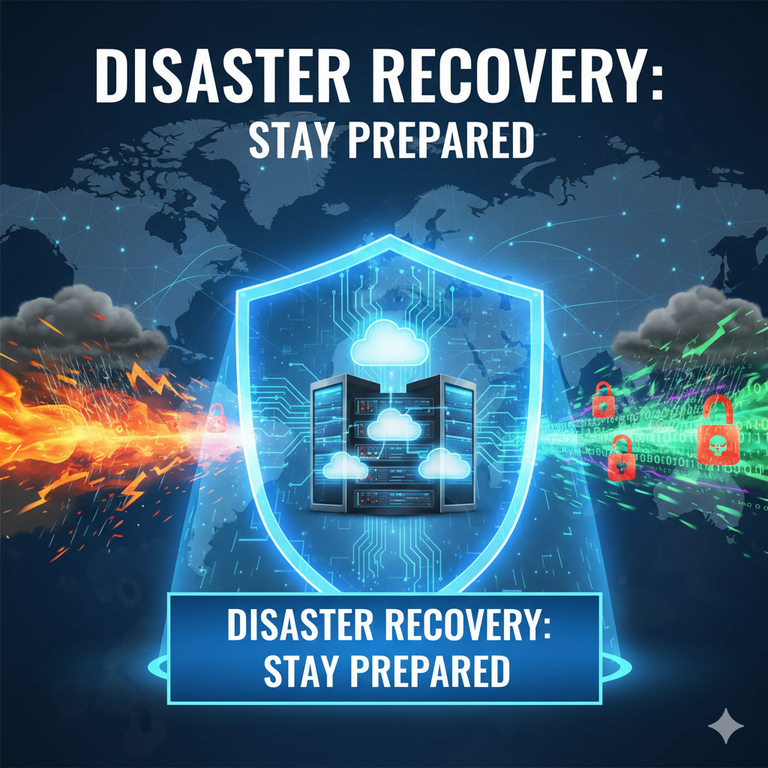
What is Disaster Recovery?
Disaster Recovery (DR) is the process of restoring access to your data, systems, and IT operations after an unexpected disruption. It’s about making sure your business can bounce back quickly from anything that goes wrong.
Think of DR like an emergency generator: you hope you never need it, but when the lights go out, it’s the difference between business as usual and total shutdown.
Why Disaster Recovery Matters
Disasters aren’t just hurricanes and earthquakes—they include cyberattacks, power outages, or even human error. Without a plan, businesses risk:
- Losing critical data
- Downtime that stops operations
- Financial losses from halted transactions
- Damage to brand reputation
- Legal or compliance issues in regulated industries
A strong DR plan ensures that even if disaster strikes, your systems and data are safe, and your customers aren’t left waiting.
Common Disasters Businesses Face
Different businesses face different threats, but some are universal:
- Cyberattacks & Ransomware
- Hackers are constantly evolving their methods. A ransomware attack can lock you out of your data until you pay a ransom. Without backups and recovery, your entire business could be held hostage.
- Hardware & System Failures
- Servers crash, hard drives fail, and networks go down. It’s not a matter of if, but when.
- Natural Disasters
- Floods, fires, and storms can destroy physical offices and data centers.
- Power Outages
- Even a short blackout can disrupt operations—especially in businesses that rely on real-time services.
- Human Error
- Mistakes happen. Files get deleted, settings misconfigured, and systems taken offline accidentally.
Key Elements of a Disaster Recovery Plan
A DR plan isn’t just a set of backups—it’s a blueprint for getting back on your feet quickly. Here are the essentials:
- Data Backup Strategy
- Always keep multiple copies of your data, stored both onsite and in the cloud. Automate backups to reduce human error.
- Cloud Recovery
- Cloud solutions make it easy to replicate your systems and restore them fast from anywhere.
- Business Continuity Planning (BCP)
- DR is part of a bigger picture: Business Continuity. This ensures operations continue—even if your office or systems are unavailable.
- Testing and Updates
- A plan is only good if it works. Regularly test your recovery process to find weaknesses and keep it updated as technology evolves.
Real-Life Example: The Cost of Downtime
Imagine an online store making $10,000 in sales per hour. If a cyberattack takes down the site for six hours, that’s $60,000 gone—not including the angry customers who may never return.
Now imagine if that same business had a DR plan in place. They could restore their site within 30 minutes, protect customer trust, and minimize losses.
Benefits of Disaster Recovery
A solid DR strategy provides more than just peace of mind:
- Protects customer trust by ensuring services are reliable
- Reduces financial losses by minimizing downtime
- Ensures compliance with data protection regulations (like GDPR)
- Strengthens competitive edge—businesses that recover faster win customer loyalty
Affordable DR Options for Small Businesses
Some business owners assume disaster recovery is only for big companies. That’s a myth. Affordable options exist:
- Cloud-based backup services (like AWS, Microsoft Azure, or Google Cloud)
- Local storage with offsite replication
- DR-as-a-Service (DRaaS) providers who manage recovery for you
- Employee training to avoid human error and phishing scams
Even a small investment in DR can prevent huge losses.
Global Trends in Disaster Recovery
Technology is making DR smarter and faster:
- AI-driven Recovery: Artificial intelligence can predict failures and trigger automatic responses.
- Hybrid Cloud: Combining local and cloud recovery for flexibility and cost savings.
- Automation: Faster recovery with minimal human intervention.
- Zero Downtime Systems: Solutions designed to keep businesses running without interruption.
Steps to Start Your Disaster Recovery Plan
- Identify Risks: What disasters are most likely in your industry and location?
- Prioritize Assets: Which systems and data are most critical to keep your business running?
- Choose Backup Methods: Onsite, cloud, or hybrid.
- Set Recovery Objectives:
- Recovery Time Objective (RTO): How quickly do you need to restore systems?
- Recovery Point Objective (RPO): How much data can you afford to lose?
- Test Your Plan: Run simulations to see how well your plan works.
- Train Staff: Everyone should know what to do in case of disaster.
Summary
Disasters—whether cyberattacks, natural events, or human mistakes—are inevitable. What matters is how prepared your business is to recover. A strong disaster recovery plan reduces downtime, protects customer trust, and saves money.
The time to act is now. Don’t wait for disaster to hit—start building your Disaster Recovery plan today.
